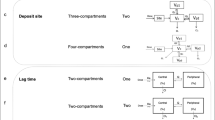Summary
To evaluate dose proportionality and absolute bioavailability of a new enteric-coated pellet formulation of pamidronate disodium (AREDIA), nine females (aged 52–66 years) were given three different single peroral doses of pamidronate disodium (75, 150, and 300 mg) and an i.v. infusion of 15 mg over 30 minutes at constant infusion rate. Repeated peroral doses (75 and 150 mg) were administered to 12 females (aged 51–70 years) for 10 consecutive days. Urinary excretion of pamidronate after peroral and i.v. administration was used for estimation of pamidronate absorption. Renal excretion of pamidronate ranged from 0.01% to 0.35% of dose, with mean values of 0.11, 0.16, and 0.18% for 75, 150, and 300 mg, respectively. After i.v. infusion, the renal excretion of pamidronate was 26–53% of the dose, lower than for other bisphosphonates. The absolute bioavailability was 0.31% (range 0.08–0.7%) after 75 mg, 0.43% (0.01–1.20%) after the 150-mg dose, and 0.48% (0.07–1.06%) following 300 mg of pamidronate disodium. Urinary excretion after the 10th intake showed a significant increase (difference 0.07% (range -0.003-0.29%),P < 0.02) when compared with the first dose. In conclusion, intestinal uptake of pamidronate was low with high intraindividual variation, like other bisphosphonates.
Similar content being viewed by others
References
Reid IR, King AR, Ibbertson HK (1988) Prevention of steroidinduced osteoporosis with (3-amino-1-hydroxypropylidene)-1,1-bisphosphonate (APD). Lancet 1:143–146
Storm T, Thamsborg G, Steiniche T, Genant HK, Sørensen OH (1990) Effect of intermittent cyclical etidronate therapy on bone mass and fracture rate in women with postmenopausal osteoporosis. N Engl J Med 322:1265–1271
Yakatan GJ, Poynor WJ, Talbert RL, Floyd BF, Slough CL, Ampulski RS, Benedict JJ (1981) Clodronate kinetics and bioavailability. Clin Pharmacol Ther 31:402–410
Pentikäinen PJ, Elomaa I, Nurmi A-K, Kärkkäinen S (1989) Pharmacokinetics of clodronate in patients with metastatic breast cancer. Int J Pharmacol 27:222–228
Fogelman I, Smith L, Mazess R, Wilson MA, Bevan JA (1986) Absorption of oral diphosphonate in normal subjects. Clin Endocrinol 24:57–62
Reitsma PH, Teitelbaum SL, Bijvoet OLM, Kahn AJ (1982) Differential action of the bisphosphonates (3-amino-lhydroxypropylidene)-1,1-bisphosphonate (APD) and disodium dichloromethylidene bisphosphonate (C12MDP) on rat macrophage-mediated bone resorption in vitro. J Clin Invest 70:927–933
Hyldstrup L, Mogensen N, Jensen GF, McNair P, Transbøl I (1984) Urinary 99m-Tc-diphosphonate excretion as a simple method to quantify bone metabolism. Scand J Clin Lab Invest 44:105–109
Flesch G, Hauffe SA (1989) Determination of pamidronate disodium in urine by pre-column derivatization with fluorescamine, high-performance liquid chromatography and fluorescence detection. J Chromatography 489:446–451
Recker RR, Saville PD (1973) Intestinal absorption of disodium ethane-1-hydroxy-1,1-diphosphonate (disodium etidronate) using a deconvolution technique. Toxicol Appl Pharmacol 24:580–589
Subramanian G, McAfee JG, Blair RJ, Kallfelz FA, Thomas FD (1975) Technetium-99m-methylene disphosphonate-a superior agent for skeletal imaging: comparison with other technetium complexes. J Nucl Med 16:744–755
Arnoux P, Assouline C, Verschuere B, Guyonnet J, Berger Y, Cano JP (1989) Pharmacokinetics of (4-chlorophenyl) thiomethylene biphosphonic acid, a new bisphosphonate, in monkey. Calcif Tissue Int 44 (suppl):s-102
Leyvraz S, Hess U, Flesch G, Bauer J, Hauffe S, Ford JM, Burckhardt P (1992) Pharmacokinetics of pamidronate in patients with bone metastases. J Natl Cancer Inst 84:788–792
Wingen F, Schmähl D (1987) Pharmacokinetics of the osteotropic diphosphonate 3-amino-1-hydroxypropane-1,1-diphos-phonic acid in mammals. Drug Res 37:1037–1042
Author information
Authors and Affiliations
Rights and permissions
About this article
Cite this article
Hyldstrup, L., Flesch, G. & Hauffe, S.A. Pharmacokinetic evaluation of pamidronate after oral administration: A study on dose proportionality, absolute bioavailability, and effect of repeated administration. Calcif Tissue Int 53, 297–300 (1993). https://doi.org/10.1007/BF01351831
Received:
Revised:
Issue Date:
DOI: https://doi.org/10.1007/BF01351831




